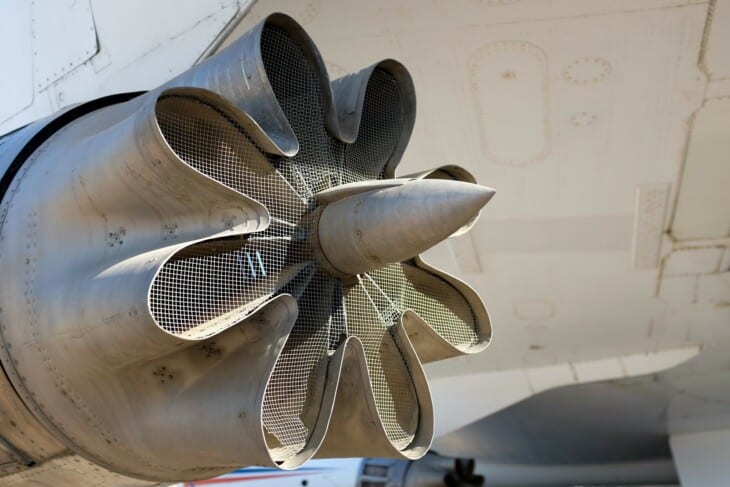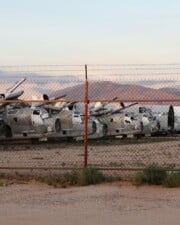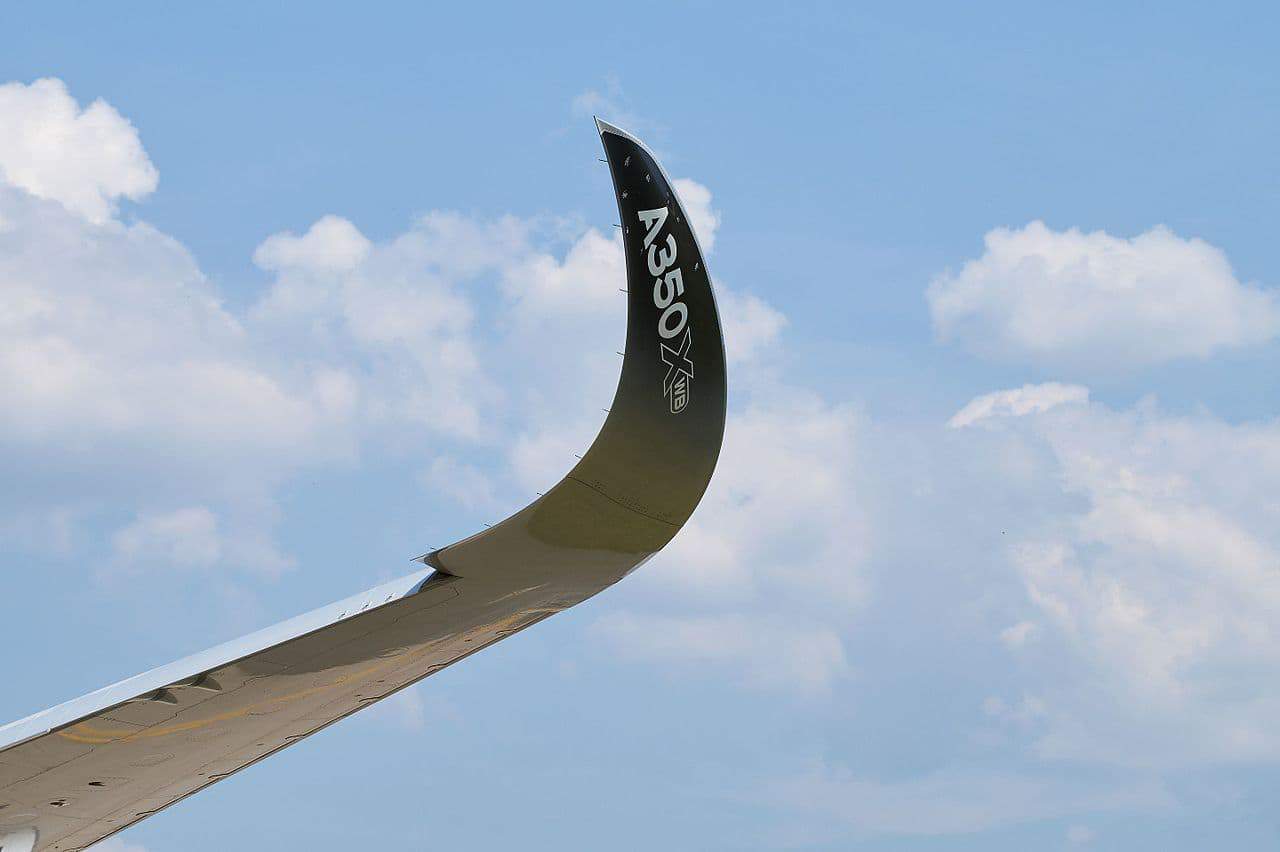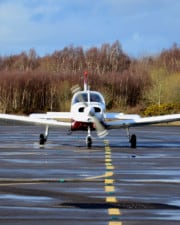It’s no secret that aircraft are loud. Over the last few decades, we’ve seen governments attempt to limit how loud aircraft can be at airports, especially those close to highly built-up areas.
Whilst most modern commercial jet aircraft easily comply with these regulations, many older jets do not, and as such, risk being banned from landing at airports in some of the world’s largest aviation markets like the US.
This has helped development of something called a “hush kit” but what exactly are they and how exactly do they work?
A hush kit is an after-market aerodynamic device designed to reduce a jet engine’s noise. They are typically added to the rear of an older jet engine and work by making small alterations to the engine’s structure to increase air bypass going through the engine.
How Does a Hush Kit Work?
Hush kits are typically installed on older jet aircraft – the kind that use either low-bypass turbofan or earlier turbojet engines. These types of jet engines are typically far louder than the high-bypass turbofan engines found on most modern airliners.
When installed on one of these aircraft, a hush kit works by mixing the exhaust gasses in the engine itself with surrounding air and the air passing through the engine.
This works to boost the amount of air going through the engine (the air bypass) and reduce some of the shear (from the air being pushed out of the rear of the aircraft) that creates the high-pitched noise associated with those kinds of engines.

Aside from this, most hush kits also make alterations to the aircraft’s exhaust.
The tailpipe is replaced by one more able to absorb vibrations, whilst guide vanes were added to help direct the air out of the engine more efficiently by increasing total area. Revised inlet nacelles also tend to replace the nacelles previously installed on the aircraft.
When all these things are combined together, a hush kit can reduce noise by anywhere from 10 to 30% depending on the aircraft, allowing it to conform with noise abatement legislations in different countries.
Which Aircraft Have a Hush Kit Installed?
As of the time of writing, the aircraft that have, or have had, a hush kit installed include:
- Boeing 707
- Boeing 727
- Boeing 737-100
- Boeing 737-200
- Dassault Falcon 10
- Dassault Falcon 20
- Douglas DC-8
- Douglas DC-9 (McDonnell Douglas MD-80 series included)
- Gulfstream II
- Gulfstream III
- Gulfstream IV
- Learjet 23
- Learjet 24
- Learjet 25
- Learjet 28
- Lockheed L-1011 TriStar
- North American/Rockwell Sabreliner
- Sud Aviation Caravelle
- Tupolev Tu-154

How Much Does a Hush Kit Cost?
As they are an aftermarket addition, and one rarely made by the engine manufacturer themselves, hush kits can vary wildly in price. However, they typically range anywhere from $100,000 to a little over $1 million.
The main reason for such a huge difference in price is down to the aircraft.
Hush kits designed for larger aircraft, or those with a high number of units built (and more importantly, that are still in service), are likely to cost more than smaller or less popular aircraft, simply on account of the laws of supply and demand.
For example, the cost of a hush kit on a Learjet 25, an aircraft with a respectable 369 units built, but relatively few still active in the US, is about $135,000. By contrast, the cost of a hush kit for a GIII, which had fewer units built overall but more active in the US, is an estimated $1.25 million.
Do Hush Kits Affect an Aircraft’s Price?
A common theme among aftermarket additions is that they tend to negatively affect an aircraft’s price. But due to the nature of hush kits extending the service lives of old aircraft, it’s actually the opposite: they have a positive impact.
When comparing the prices of two similar aircraft (similar condition, total time, time before overhaul etc.), one of which has a hush kit installed, the other of which doesn’t, the hush kit-installed model will generally carry a higher price.
Chiefly, this is because the aircraft – despite its age – is more appealing to a greater number of potential customers, and means a potential operator doesn’t have to fork out for a hush kit installation of their own before they can begin operating it.
That being said, when the US announced further noise restrictions in 2013, ruling that all aircraft must be Stage 3 noise compliant, the price of jets like the Boeing 727, GIII and Falcon 20 collapsed.
This price collapse included those jets who already had hush kits installed, and thus complied with the FAA’s Stage 3 noise standards. Even a decade later, the prices of these jets have never recovered.
Who Invented The Hush Kit?
Whilst the idea of a hush kit-like device has been around since the 1960s, the first modern hush kit as we’d know them today was invented by Thomas W. Carr, Alan Marsh and Philip Rose in the mid-1980s.
The trio applied for a patent in July 1987, which was granted in April 1989 by the US Patent Office. They then licensed their technology out to different companies who then developed their own hush kits for specific aircraft.
Their patent expired in April 2006, meaning, rather interestingly, the basic technology for how hush kits work is actually in the public domain. That being said, however, most aircraft that need a hush kit, have had one installed already.
Interestingly, the trio also designed and patented the world’s first quiet nacelle system (also called revised inlet nacelles) around the same time. As we saw above, quiet nacelles are often paired with hush kits to further reduce the noise pollution created by jet engines.
How Much Do Hush Kits Weigh?
Because hush kits are designed for a specific aircraft, and each manufacturer takes a different approach to how they design their hush kit, the weight of a hush kit varies considerably.
As a general rule, they weigh anywhere from 200 lb (90 kg) to 1000 lb (450 kg). For the most part, the weight of a hush kit is directly proportional to the weight and size of the aircraft. This means a hush kit installed on a 727 will weigh more than one on a Learjet.
But despite hush kit manufacturers’ best efforts, this added weight does adversely affect the performance of the aircraft.
Whilst the exact numbers vary from aircraft to aircraft and hush kit to hush kit, the addition of a hush kit reduces range by an average of 1.4% and cruise speed by an average of 1.7%. That being said, the reduction in range and speed is negligible for most operators.
Do Hush Kits Reduce Cabin Noise?
Whilst hush kits are not expressly designed to reduce cabin noise of the aircraft they’re installed on, by reducing the noise the engines produce, hush kits do have the unintended consequence of reducing cabin noise.
The extent to which hush kits reduce cabin noise, however, varies from aircraft to aircraft, ranging from negligible to considerable.

Particularly among “newer” American-made jets (everything’s relative when it comes to talking about old aircraft), or simply those that are smaller (eg. the business jets) the addition of a hush kit barely reduces cabin noise.
Among Russian-made jets, however, which are somewhat famous for being much louder than their Western-made counterparts, the addition of a hush kit is certainly noticeable.
Do Other Countries Require Hush Kits?
For the most part, hush kits are a very American thing. Looking at the countries where hush kits are used the most, the US is in first place by quite a margin.
That being said, the legislation that led to the widespread adoption of hush kits in the US is not unique. Many countries and political blocs have their own legislation restricting aircraft noise.
To that end, you will find many aircraft in places like the UK, EU and various Asian countries with hush kits installed.
However, you’ll also find that many other countries have banned hush kits. This is not because they believe installing a sound dampening device on an aircraft is dangerous (most evidence points to the contrary) but because of their own legislation.
You see, hush kits were designed to make aircraft Stage 3, and more recently, Stage 2, noise compliant. In places like Switzerland, Japan, Australia, Macau and Singapore (among others), Stage 2 is already banned.
In other words, they need to be so quiet that not even installing a hush kit would make them quiet enough. As a result, you’re unlikely to see aircraft equipped with hush kits in those places (at least, until/if even quieter hush kits are developed and installed!)
Do Military Jets Need Hush Kits?
Regardless of the country, the regulations that create the need for hush kits are specifically aimed at commercial jets and airports. As a result, military jets who (generally) fly from military airfields not commercial ones, do not need to be installed with hush kits.
Even when they’ve retired, and a few have made their way into the hands of private collectors, museums and airshow display teams, no current regulations require them, and as of the time of writing, there is no privately-owned fighter jet equipped with a hush kit. Even those with afterburners.
At least in theory, assuming a hush kit was developed for a military jet (either active or retired) and the owner was willing to allow it, a hush kit could be installed on a fighter jet of some kind.
Due to the fact that there isn’t a need for a fighter jet of any kind to be quieter, the chances of this happening are slim at best.
Related Posts













